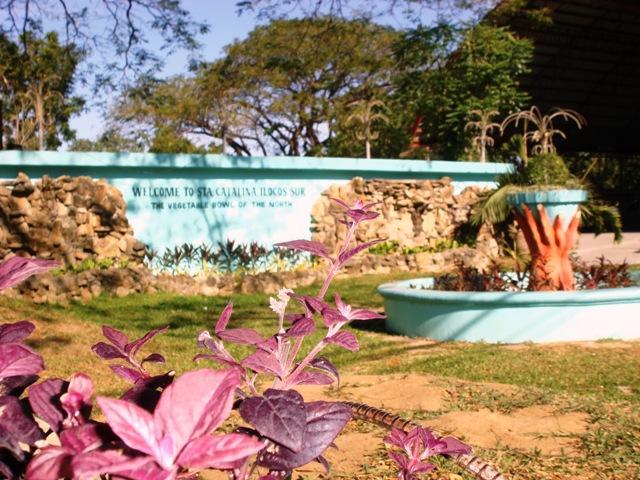
We’d love to hear from your experience with us – Sta. Catalina’s Government.
Origin of Sta. Catalina
When the conquistador Juan de Salcedo travelled inland, he also was looking for fresh water, since the area where he landed yielded only salty water. When they finally found fresh water, one of his men saw an apparition of Saint Catherine of Alexandria near the place where he drank. He reported this to Salcedo, and named the place Santa Catalina. A replica of the cross once planted by Salcedo and his party--to signify that the Spanish has conquered the area--stands near the entrance to the municipality.
Rich Agriculture
Dubbed as the “The Vegetable Bowl of the North”, Sta. Catalina’s vegetable production brings a lot of income to farmers. The town is utilized for crop production and next to rice/corn season, farmers also plant vegetables like onions, cabbage, cauliflower, sweet pepper, eggplant, beans, tomato, sweet potato, yam beans, mongo and peanut.
Livestock such as cows and water buffalo were being raised to help farmers in their farm needs and serves as working animal. Likewise goats were raised but not in herds and these are for local and home consumption of the farmers. Most farmers raised fighting cocks which commands higher prices in the market. There are also presences of fishponds around the town. It has a Light-Medium bamboo craft industry located at Barangay Pangada which is at present exporting bamboo-based finished products
Tourism
- Sta. Catalina can rightfully boast of its centuries-old church which was built during the 17th century, it has baroque architecture and antique images of saints and a big "campana"- a 15th century vintage bell made of copper and gold which was brought by the Spaniards in the 15th century.
- An additional attraction is the “COMEDIA” a cultural heritage which passed through generations. It depicted the lives of Non-Christians and Christians alike during the period. An oral tradition states that there was a year where, for some reason, the residents of Sta. Catalina were not able to perform the COMEDIA. For this, they attribute the seas becoming rough and violent. Fishing for livelihood consequently became difficult. It is said that after that incident, the residents never again would let another year pass without performing the COMEDIA.
- Agricultural produce, which is the town's One-Town-One-Product (OTOP) offering, is also one of Sta. Catalina's tourist come-ons.
- And of course, there is Sta. Catalina's powder-soft beach with gentle, rolling sand dunes. Half of the year (November to May) can be best enjoyed by going the seemingly unending sea coast under a tropical sun! Feel the salt spray on your face and experience an ice-cold beer on a sea side campfire while roasting a fresh fisherman's catch of tuna, mackerel, "siganidae", snappers, "buslogan", "lapu-lapu" (grouper), "sungayan", squid, cuttlefish, and "baraniti".






How to get there
Sta. Catalina is accessible by various transport vehicles from Manila and other nearby provinces and cities. It may be reached through public utility buses which range from ordinary, first class air conditioned, up to cozy deluxe types. Car rentals are most available at the international airport.
By Land - Vigan City, which is only 3 kilometers away, has sufficient transport system. There are four Bus Companies operating within the its vicinity such as: Philippine Rabbit Bus Line, Dominion Bus Corp., Partas Trans. Co. and Aniceto Transportation. They operate direct bus services from Vigan City to Manila, Baguio, Laoag and other parts of Luzon.
By Air - Mindoro Airport is located just 2 kilometers away from Sta. Catalina. It has one asphalted runway, 900 meters long and 30 meters wide. At present, only chartered and private planes use it. However, the Laoag International Airport in nearby Laoag City caters to commercial domestic planes as well as international flights particularly to and from Taipei, Taiwan and certain parts of mainland China. Special arrangements may also be done for private taxi services to Sta. Catalina, Ilocos Sur through proper coordination with the available van rentals in Vigan.
Where to stay
People in Sta. Catalina are hospitable by nature. They can offer you to stay in their home and be their guest of honor for the time being while you are visiting there. However, if you wish to stay somewhere private, there are lots of accommodations at nearby Vigan City which is just less than 5 minutes away:
- COSTA DEL SOL Paratong Beach, Sta. Catalina, Ilocos Sur
- CORDILLERA INN Mena Crisologo St., Vigan City
- EL JULIANA HOTEL Liberation cor. Quirino Blvds., Vigan City
- GRANDPA’S INN 1 Bonifacio St., cor. Quirino Blvd., Vigan City
- GORDION INN V. delos Reyes cor. Salcedo Sts., Vigan City
- LA FELIZA INN 8 delos Reyes cor. Florentino Sts., Vigan City
- MOM’S COURTYARD Bongtolan, Vigan City
- RF ANICETO MANSION Plaza Burgos, Vigan City
- VIGAN HOTEL P. Burgos cor. V. delos Reyes Sts., Vigan City










